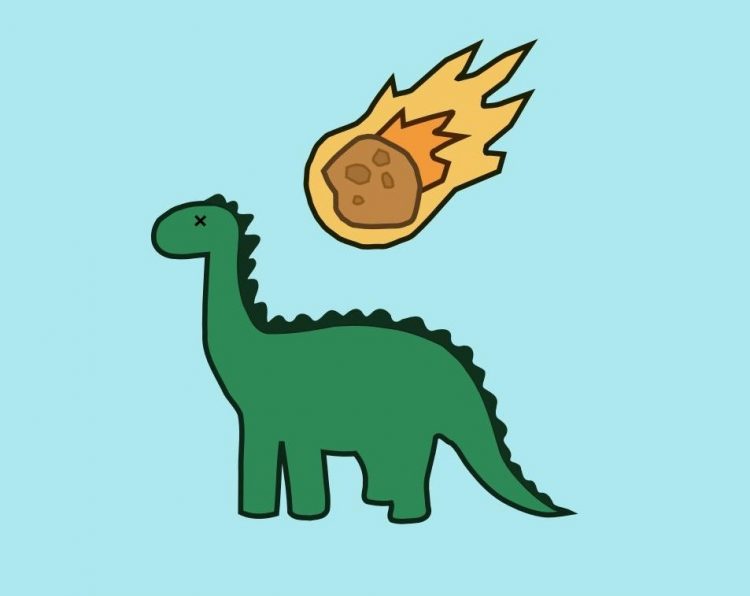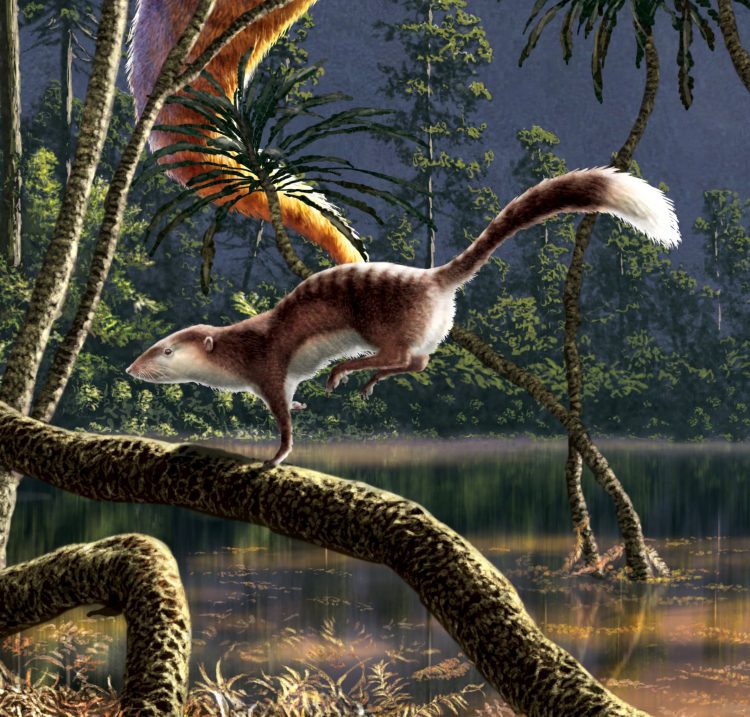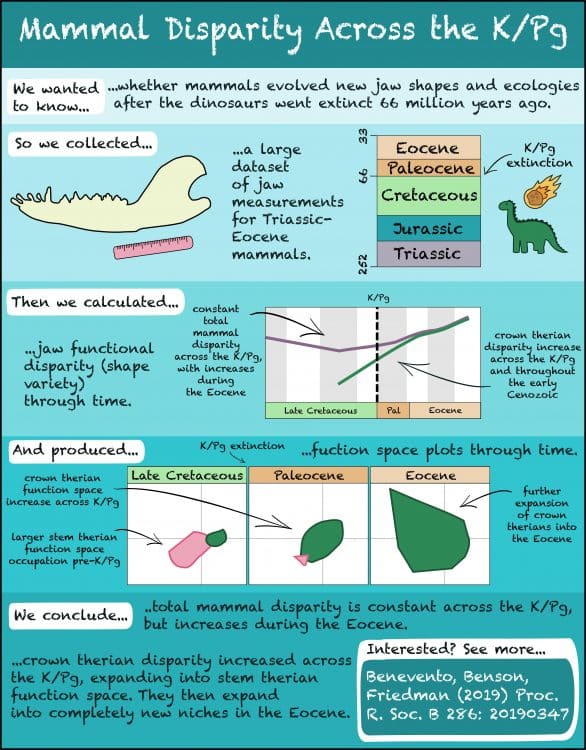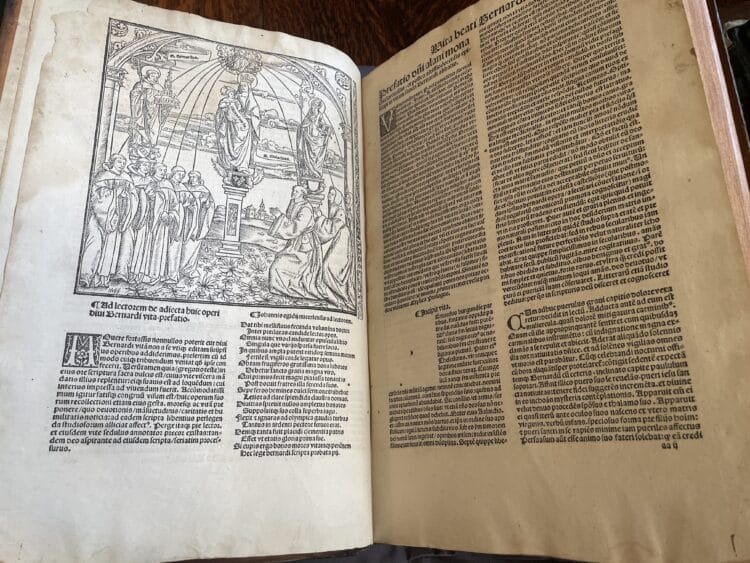Mammals During the Extinction of Dinosaurs
8 May 2019|
- Research

Everyone knows that dinosaurs are extinct. This occurred 66 million years ago when a meteorite 10 km in diameter struck the Earth, causing the ‘Cretaceous/Palaeogene extinction event’ (K/Pg event, for short). The cataclysmic effects included large-scale wildfires, followed by a long period of darkness due to atmospheric dust, and the shutdown of plant growth, both on land and in plankton. Many groups became extinct, not just dinosaurs, but also others such as pterosaurs (flying reptiles) and ammonites (relatives of squids, with coiled shells). Even among survivors such as birds, mammals, lizards and turtles, many individual species became extinct.
The Earth was never the same again. We, as mammals, are largely beneficiaries of this. Mammals underwent a dramatic evolutionary radiation straight after this extinction. Larger-sized mammals (greater than 10 kg) evolved for the first time. Early relatives of many living mammals, including rodents, primates and hoofed mammals, made their first appearances in the fossil record only shortly after the extinction of dinosaurs. Indeed, the evolutionary diversification of mammals, and their abundance and diversity in ecosystems today, is often described as resulting directly from the extinction of dinosaurs. There are some wrinkles to this hypothesis — some groups of mammals underwent earlier radiations, and others don’t seem to really get going until somewhat later. Nevertheless, events of 66 million years ago might have been catastrophic for dinosaurs, but they were great news for mammals.

All of this seems well known. However, nothing is ever simple, and quantitative studies have a great potential to answer questions about evolutionary history. For a long time, mammals from the age of dinosaurs were known almost solely from teeth. Fossil discoveries of the past decade included whole skeletons from several continents, and especially from China. These showed that these early mammals actually had a wide range of ecologies: They included mole-like diggers, beaver-like swimmers, climbers, gliders and others. They also ate a wide range of different foods, including insects, plants, and other vertebrates, and some even ate dinosaurs! So how different really were they to the mammals of today?
This week, my former DPhil student, Dr Gemma Benevento published a study that aims to understand this, in collaboration with myself and our colleague Matt Friedman. She studied the jaw structure of mammal species spanning a large chunk of their early evolution: from about 200 million years ago up to 50 million years ago. Jaws are important to the business of being a mammal: their structure can tell a lot about the foods that are eaten, and the amount of variation in jaw structure among species relates to the amount of variation in diets among these mammals. More variation in fossil jaws equals more variation in ancient diets. We call this variation ‘disparity’, and use it as a way of inferring how much variation in dietary ecologies there might have been among species in the past.

Today’s mammals, and their jaws, show lots of disparity. But how much disparity was present among mammals from the times of dinosaurs? And what happened to mammal jaws after the extinction of dinosaurs? Did mammals expand their disparity of jaw types (and, by implication, their disparity of diets)? By how much? And how quickly?
To answer these questions, Dr Benevento measured jaws from a few hundred species. Jaws work like levers or beams, and she chose measurements that describe mechanical advantage, bending strength, and other key functional properties with close relationships to how mammals eat.
Our analyses showed that mammals had quite high disparity during the times of dinosaurs. Indeed, we were surprised to find that mammalian jaw disparity did not increase at all during the first 10 million years after the extinction of dinosaurs. Why were we surprised? Well, because many other things did change in this time. Mammals dramatically increased their species counts and abundance in ecosystems. Large-bodied mammals appeared for the first time. And early relatives of key living groups appeared. So this formative burst of mammalian evolution had occurred, but from the perspective of jaws and diets, little had changed. Indeed, mammals waited much longer, around 15 million years, during an interval of time known as the Eocene, before their disparity of jaws expanded beyond what was seen in the age of dinosaurs.
We proposed several take-home messages from this. Firstly, we think this shows that mammals from the times of dinosaurs were actually very disparate. They were restricted to small body sizes, from mouse- to badger-sized, but they really ruled the roost at those sizes, perhaps doing much of what they do today. Second, extinction of the dinosaurs allowed them to expand beyond this, but only slowly compared to the speed with which they increased their body size range and species numbers. We think this means that evolution can make some changes rapidly (e.g. body size increases), but others only slowly (jaw structure and function).
Finally, we were surprised that whilst mammals were hit hard by the K/Pg mass extinction event (many species and whole subgroups became extinct) they nonetheless maintained their jaw disparity. This occurred because Theria (the group that includes ourselves, plus other placental mammals, plus marsupials) expanded rapidly to fill the void left by extinction of ‘archaic’ groups. For me, this calls into question the idea that mammalian evolution was shaped so strongly by extinction of dinosaurs. Of course this must have played a role in allowing conspicuous large sizes of today’s mammals, but the diversification of many living groups right after the K/Pg extinction event might largely have resulted from the extinction, not of dinosaurs, but of other mammals.
Benevento GL, Benson RBJ, Friedman M. 2019. Patterns of mammalian jaw ecomorphological disparity during the Mesozoic/Cenozoic transition. Proceeding of the Royal Society B 286. Read it free online.
Read more on our blog
Category: Research

